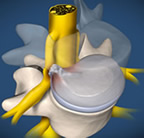Understanding Your Spine

Your Spine Deserves Special Care
Your spine is at the center of a delicately balanced system that controls all of your body’s movements. Bones, muscles, ligaments, tendons, and nerves all work together to balance the weight of your body. Even minor damage to one component of your back’s structure can upset this fragile balance and make movement painful.
It is not surprising, then, that back pain is second only to headache as the most common cause of pain, or that 8 out of 10 people will have a problem with back pain at some time. The causes of back pain can be simple or complex; the vast majority can be treated nonsurgically, but in some serious cases, surgery is necessary.
What Causes Back Pain?
Back pain occurs when one or more nerves in the spinal column become impinged, or pinched. This is commonly caused by a disc or bone spur pushing into the canal that houses the spinal cord, the cauda equina, and the nerve roots.
At birth, discs are comprised primarily of water, but they tend to dry and shrink as a person ages, causing changes in the spinal column. Further changes can occur when a disc ruptures or herniates (protrudes) because of injury. Very often in response to these changes, tissue around the spinal canal thickens, reducing the space in the spinal canal. This narrowing is commonly called stenosis. Additionally, when the facet joints degenerate, they become larger, form spurs, and can pinch the nerve roots or even the spinal cord.
If you are unable to function at an acceptable level for your lifestyle, or your neurological deficit is becoming progressively worse in spite of conservative treatment, then surgery is often the recommended treatment. In the vast majority of cases, modern spinal surgery is extremely successful in alleviating pain and restoring mobility.
There are a number of different surgical approaches to relieving back pain. The following is a general description of some of the most commonly performed procedures:
- Discectomy – the removal of all or part of the offending disc
- Decompression – the removal of bone spurs
- Corpectomy – the removal of a vertebra
- Fusion – the joining of discs to prevent motion in the affected area
Spinal surgery, as with any major surgery, is not without risks.
Understanding Spinal Anatomy
Your spine is a strong and flexible bony structure, made up of five sections from the neck to the tailbone, consisting of 33 bones or vertebrae.
1. Cervical spine (neck)
2. Thoracic spine (upper back)
3. Lumbar spine (lower back)
4. Sacrum
5. Coccyx (tailbone)
In the cervical, thoracic, and lumbar areas, cushion-like discs separate the vertebrae, giving the spine the ability to bend and turn. There are five vertebrae in the sacrum, but they are fused naturally and do not have discs to separate them. The coccyx has four smaller vertebrae that also are fused.
The Cervical Spine
The cervical spine (neck) consists of seven vertebrae numbered C1 through C7 from top to bottom. Each of the top two vertebrae has a unique design. C1 is a two-tiered ring that is attached to the skull. C2 has a protrusion that acts as a post around which C1 rotates. C1 and C2 are primarily responsible for the motion of the head. Each of the remaining vertebrae in the cervical, thoracic, and lumbar regions has a pair of facet joints that connect to muscles and ligaments to keep the vertebra in place, as well as a disc, which cushions the spine and allows it to move.
The Thoracic Spine
The thoracic spine (upper back) consists of 12 vertebrae that are attached to the ribcage. Very little motion occurs in this region and problems in this area are relatively uncommon.
The Lumbar Spine
The lumbar spine has five vertebrae. This region endures a lot of stress, especially when you bend, and is a common source of back pain.
The Spinal Cord
The spinal cord runs from the brain through the cervical and thoracic spine, where the nerve roots come off the cord to form the cauda equina, or “horse’s tail.” At each level of vertebra, a nerve root exits on each side of the spine to the right and the left.
In the cervical spine, the nerve root is labeled according to the lower segment that it runs between; in the lumbar spine, the nerve root is named after the upper segment that it runs between. That means that the C5 nerve root runs between C5 and C4, and the L4 nerve root runs between L4 and L5.
